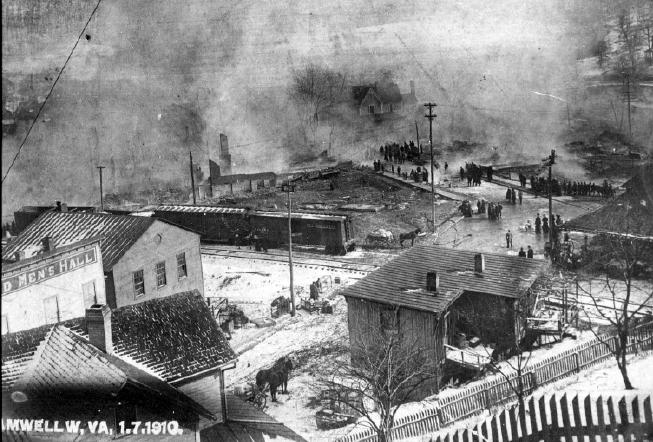Over the past year I have been writing a book about the Sulfaro family. A large section is dedicated to Paolo Sulfaro, my great-grandfather, who traveled back-and-forth between Sicily and West Virginia to work in the coal mines before his death in WW1. I have pieced together his life through records but experiencing the places where he lived is a much better way of bringing him back to life.
I’ve always wanted to see the little town of Bramwell, where Paolo lived as a coal miner, but it’s in a remote part of the country and not close to my home in Northwest Arkansas. Finally the opportunity arose for a short and inexpensive road trip. My husband, Addam, was supposed to speak at a conference in New Jersey but when that fell through we decided to go east anyway and make Bramwell our target destination.

Bramwell is 949 miles (approx. 14hrs) from where we live so to make the most of this little trip we added a few more stops through Tennessee, North Carolina, South Carolina and Georgia.
Driving to Bramwell from the Great Smoky Mountains
After a short visit to the Great Smoky Mountains we took Interstate 81 northeast through the top corner of Tennessee into West Virginia and turned onto Interstate 81 to travel north up to Bramwell. When we reached the George Washington and Jefferson National Forests an ominous gray cloud spat at us but nothing could detract from the beauty of the scenery. The leaves on the sea of trees were already changing color and I could imagine in just a week or two they would be a textbook example of Fall in the south.
We passed through a couple of tunnels and my excitement grew as I started to recognize town names on the signs. With bated breath I watched our little GPS dot get closer and closer to Bramwell. I’d spent the better part of 10 years studying the map of this area and wondering what it would be like to visit.
20th Century vs 21st Century Bramwell
We reached Bramwell at around 2pm. The gray clouds had moved south and we had perfect, sunny weather. Addam stopped the car so I could take a photo of the sign:

As we drove through winding roads into this little town I was struck by the number of desolate buildings, some unoccupied and reclaimed by nature, others in a state of disrepair but usable. It reminded me of Detroit, which is no surprise as both Bramwell and Detroit rose and fell with the growth and decline of an industry.
It’s hard to try to conjure your ancestor’s memory in a place that has been changed by time. Paolo lived in Bramwell during its heyday over 100 years ago and I would need a strong imagination to feel like I was actually retracing his steps.
At the turn of the 20th century there were 4000 residents and at one point 14 millionaires (coal and banking magnates) who called Bramwell home. Having now visited the town in person I can’t fathom how so many people were living there together but they did and they thrived there. Today the population of Bramwell is just 364.
We crossed a little bridge over the Bluestone River, which runs through the town, and turned onto Main Street. To the right we passed The Corner Shop Diner advertising burgers, shakes and homemade fries. Next to it were some empty storefronts, the post office, a catering restaurant, and an antique store. On the left we saw Cooper House, which is one of the mansions, and at the end of the street was the Bramwell Train Depot.

Bramwell Train Depot Visitor Center
It was a Sunday so we had 2 hours left before the Bramwell Train Depot Visitor Center closed for the day. I should begin by mentioning that this building was not the original train depot and it is also known as the Coal Heritage Trail Interpretive Center. The original train depot was torn down in the 1950s. These days the reconstruction serves as the Bramwell Town Hall and as a museum for Bramwell and coal mining memorabilia.

Outside there were information boards describing the history of the town during the late 1800s and early 1900s. I appreciated the focus on the immigrant coal miners, showing that they were not just a footnote to the wealth and success of the coal mine owners.

Despite a decade of research there is still very little I know about Paolo’s time in West Virginia. Unlike vital records and ship manifests, the records about coal miners are not digitized or easily accessible. Bramwell does have a coal archives center I wish I could spend a few days in but we just didn’t have the time on this trip. To access it you also need to make an appointment in advance.

Addam was convinced that there are more records mentioning my great-grandfather in this town and he peered closely at every board and sign to see if he could spot the word “Sulfaro”. It’s nice to have a husband who encourages me in this obsession.

We spent a little bit of time in the gift shop where a very kind man spent 5 minutes fixing the National Parks stamp so that we could have the right date in our National Parks Passport book. After I found out that Bramwell is on the National Coal Heritage Trail and that meant another stamp in our book I felt a little better about dragging Addam to this remote little West Virginian town.

When the man asked why we were visiting Addam told him that my great-grandfather had come to work the coal mines from Sicily. I think maybe the whole town is related to immigrants from Italy because he responded that he is a great grandchild of a Sicilian who came to work there too!

Millionaire Row Walking Tour
Bramwell’s present day claim to fame are the millionaire houses. A couple of times a year the mansions are opened for public viewing, but we had not arrived on one of those days. Instead, we did the self-guided “Millionaire Row Walking Tour” using a map that takes you past all the millionaire homes with information about who built them and how they came to be in Bramwell.

We walked up Main Street and stopped briefly in the little antique store called Blue Moon Gifts, then we continued up the street to the old Bank of Bramwell (15).

Sadly, the bank, built in 1893, is just one of a handful of buildings to have survived a devastating 1910 fire that saw the destruction of 22 buildings, including most of Main Street. According to the National Register of Historic Places, the Bank of Bramwell survived due to it being built with stone, rather than wood. During later reconstruction all of the buildings on Main Street were required to be built with brick, stone, or some other mortar.

Coal companies along the railroad line actually disbursed miners to fight the raging fire. (Bluefield Daily Telegraph) I can’t help but wonder if Paolo was one of the miners who tried to put the fire out. Whether he did or didn’t I am certain that he saw the devastation and reconstruction as he was living in Bramwell at the time, and subsequently returned in 1912.

We walked through Main Street, and turned right onto S River Street, before eventually walking back toward the Train Depot via Bloch Street. The mansions were beautiful, to be sure, but not quite as big as I had imagined. After being disappointed by the state of the rest of the town I felt like at the least this tiny part of Bramwell had preserved some of the beauty of its past life. I was also surprised to see that many of the mansions are occupied by residents. It’s nice that they are protected and not sitting empty throughout the year.

The Coal Heritage Trail Interpretive Center
We went back into the Train Depot to look at some of the photos and display they had in their museum. I frantically took photos hoping to zoom in on them later and read the magnificent amount of content. I felt very disappointed in that moment that I wouldn’t be able to stay and conduct research in their archives, despite being realistic about what I’d get out of my trip. Who knows what I could find?



St. Elizabeth’s Catholic Church, Pocahontas, Virginia
Pocahontas is a little town about 5 minutes drive west of Bramwell, and across the border into Virginia. While I don’t have any hard evidence that Paolo visited this town we do have stories passed down from his niece Francesca Sulfaro that he attended baptisms of his nephews and nieces at St. Elizabeth’s Catholic Church in Pocahontas, VA.
This time I drove and Addam gave directions. There were so many churches in Pocahontas, both desolate and functioning, that I probably asked, “Is this the one?” at least four times before he got fed up and said he would tell me when we get there. (Lol)
Eventually we found the still-operating St. Elizabeth’s on the top of a hill. I got out and took a few photos but didn’t go inside.

Well, there is it — an account of our trip to Bramwell West Virginia. It has already inspired me to dig deeper into Paolo’s time in West Virginia but whether or not I uncover new information is up for debate.
I have learned through the process of writing this Sulfaro book that there’s no way to truly be “done” with recounting someone’s life. I need to draw a line, be happy with what I have, and revise it in the future otherwise you’ll never get to read it!
I would like to give special shoutouts to a few people who helped make this trip to Bramwell special. First, my supportive husband who would take me to the ends of the earth to help me in my projects. Second, to my Mum whose meticulous record keeping and document/photo preservation is the reason I know what Paolo and his wife Gaetana look like and other important details about their lives. And finally to Catina Hanak who has been an invaluable resource in this part of my research. Thanks to her I learned that Paolo was a coal miner, the subsequent lives of his siblings and their descendants, and about St Elizabeth’s.


